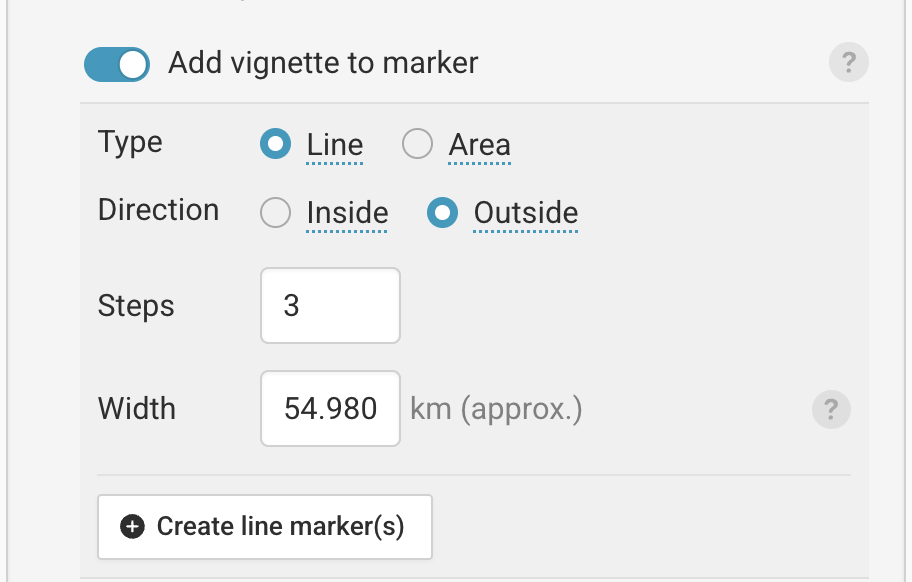How to style area & line markers
Once you've imported an area or line marker, you can style it in our Locator map tool. To do so, click on the marker you want to style in the list of markers at the top of step 1: Add markers. A box of styling settings will open below the list. Here we explain which styling settings you'll find:
- 1
-
How to style line markers
 You will find the following options when you click on a line marker:
You will find the following options when you click on a line marker: - Color: Defines the color of the line. Click on the the little color swatch to change the color.
- Width: Defines the width of the line. You can move the slider or type in a number.
- Opacity: Defines how transparent the line should be. You can move the slider or type in a number between 1% (very transparent) to 100% (not transparent at all).
- Dash: Here you can decide if your line should be one consistent line, or if it should be dashed. Play around to see what works best for your map. Please note that dashed lines look better when you use a small line width.
- Tooltip: You can determine what text shows up when readers hover over a particular line marker
We will cover the "more options" at the end of this article.
- 2
-
How to style area markers

You will find the following options when you click on an area marker:
- Fill Color: Defines the color of the area. Click on the little color swatch to change the color.
- Fill Opacity: Defines how transparent the area should be. You can move the slider or type in a number between 5% (very transparent) to 100% (not transparent at all). 0% opacity means that the area is not visible at all anymore.
- Outline Color: Defines the color of the outline surrounding the area. Click on the little color swatch to change the color.
- Outline Width: Defines the width of the outline. You can move the slider or type in a number.
- Outline Opacity: Defines how transparent the outline should be. You can move the slider or type in a number between 1% (very transparent) to 100% (not transparent at all).
- Outline Dash: Here you can decide if your outline should be one consistent line, or if it should be dashed. Play around to see what works best for your map. As you can see in the GIF above, dashed lines look better when you use a small line width.
- Tooltip: You can add a bit of text to be displayed when a reader hovers over this area marker.
You can also click on the blue switches left of "Fill" and "Outline" to switch off the fill and the outline completely. If you make both fill and outline invisible with the switches, the whole marker will become invisible.
At the bottom right, you have the option to show " Advanced options." Click on it to enable a few more features:
- 3
-
Add a vignette to an area marker
Toggle this on to add a vignette around the area marker you've selected. This is great for water elements or regions you'd like to call special attention to. For more details on vignettes, check out this post on our Blog.
-
Vignettes include a few options, including configuring whether you create a line or area, which direction the vignette extends into, how many markers that should consist of, and how far apart (approximately) those markers will be. When you've fine-tuned that to your liking, you can click Create marker(s) at the bottom to create them:
-

- 4
-
The line or area looks incomplete? "Show exact line/area" can help
The second setting under "more options" is a switch to "show exact line" (or "show exact area", if you're styling an area marker).
If you're happy with the appearance of your line/area, you can ignore this setting.
Here's why this setting exists: We automatically simplify all imported lines and areas by 37%. That helps to make the map render faster for your reader. And in most cases, the difference between a simplified and non-simplified line/area is not visible. But we found that 37% simplification can be too much for the very small line or area parts (like tiny islands). So if you're missing certain elements on the map, try turning on this setting.
- 5
-
How to change the order of areas and lines
Maybe two or more areas overlap on your map, and you're not happy with their order. To change it, you can grab and drag your markers around in the marker list:

If your map shows not just areas and lines, but also points, then they will always be on top. It's not possible to get point markers to appear below line or area markers.
- 6
-
How to change the name displayed in the marker list
If you click on "more options" in either the line marker or the area marker settings, you'll see the option to see a marker name. This name won't be displayed on the map — it's just there to let you organize and recognize your markers better in the marker list.

Since the marker name has no impact at all on the map and its appearance, you can ignore it if you only have a few markers.

 You will find the following options when you click on a line marker:
You will find the following options when you click on a line marker: 


